ESP_r Database Entities
ESP-r is distributed with a set of databases which are referenced by the exemplar models also included in the distribution. These corporate databases should be protected from accidental changes. ESP-r models can also reference model-specific databases which are safer to evolve and, since they are included in the model folders, get transported with the model if it is moved.
The ESP-r Project manager includes facilities to manage entities in most of the corporate or model specific databases. The figure below shows the initial list of corporate databases on the left and for a model which also includes local (project specific) databases on the right.
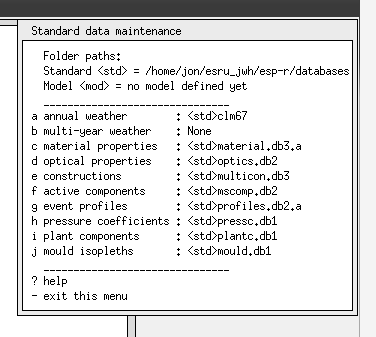
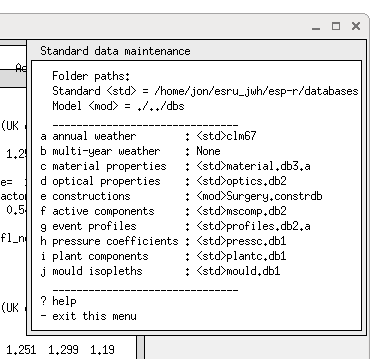
The following are the main types of databases:
Materials
This database is in tag-data format organised into categories (Brick, Concrete, Metal, Wood, Stone, Plaster, Screeds & renders, Tiles, Asphalt & bitumen, Asbestos, Insulation materials, Carpet, Glass, Earth, Board, Sheathing) as seen below:
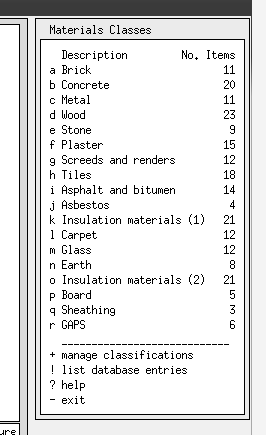
Below are the entries in the Concrete class:
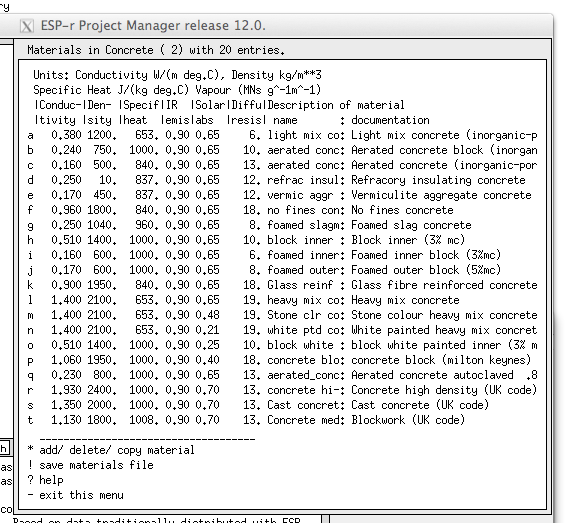
Materials have the following attributes:
transparent materials also include:
The default thickness above is only suggested. A particular type of brick or wood species is only given a specific thickness when used in a construction. Building sections are often created with non-homogeneous materials and it is possible to create new materials which merge the properties of two existing materials. Below is a material that is a mix of cellulose insulation and 7.5% wood:
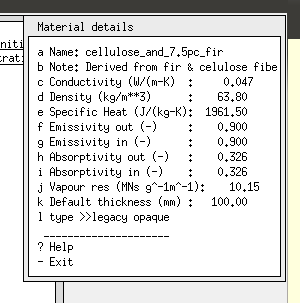
Constructions
In ESP-r constructions are named entities arranged by class e.g. opaque facade, internal partitions, doors, glazing, frames etc.
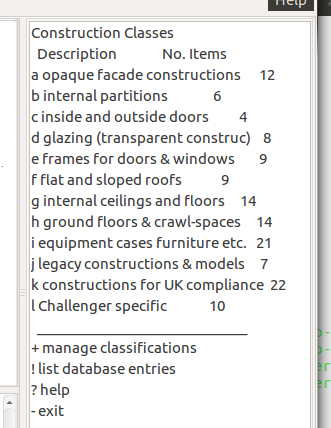
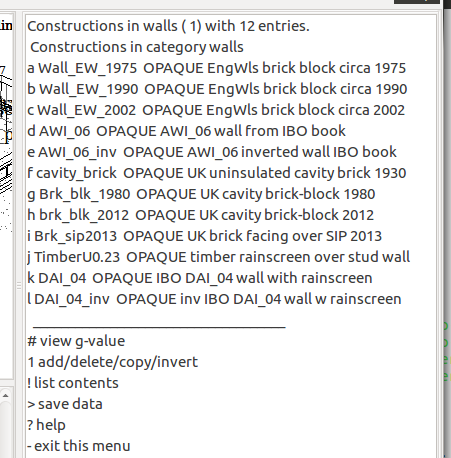
and which include the following attributes:
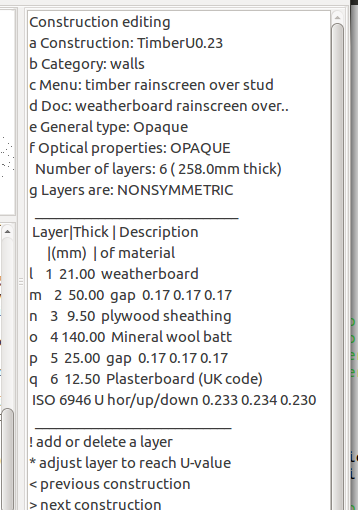
and for each layer:
The order of layers is from the outside to the inside. Note that materials thickness is required. Up to 12 layers can be accommodated. An example report about the derived attributes of a specific wall type is shown below:

Note admittance and the ISO U-values are reported but have no meaning to the simulator.
Optics
Optical databases hold sets of descriptive and numerical attributes describing the optical characteristics of glazing systems. Although entries can be manually created the usual route to inclusion is to import optical reports from third party tools such as WIS and Window 6. An optical entity includes the following:
Higher resolution BRTF transmission functions are not held in this database.
Micotoxin growth patterns
Prediction of mould growth requires a growth prediction tables for each specie. Each includes a cubic regression equation and a table with data to feed the specific equation. There is also a block of text explaining the approach taken and the particular risks associated with occurrences of this specific micotoxin.
Wind pressure distributions
Models which include mass flow networks need to transform wind speeds and wind directions from weather data into pressures at wind driven boundary nodes. The database includes data from the literature but can also host coefficients derived from wind tunnel tests or CFD studies. Each set includes
Weather
Building and system performance are dependant on weather data. Weather data from files in the Climate folder is hourly based. Many have been converted from EnergyPlus EPW files via the ESP-r clm utility. Below is a portion of the selection list for weather files:
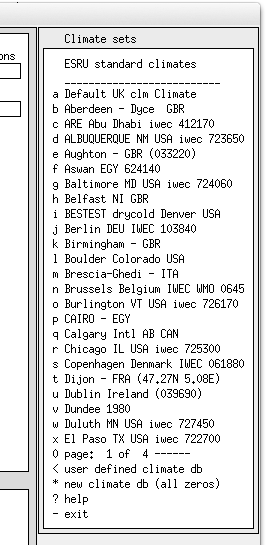
Alternatively, short time‐step weather data can be held in a so-called temporal file. If assessments were run at shorter time‐steps then the weather data source interpolated values are reported.
Each weather file includes a header with the following entries:
Then for each hour the following are held:
ESP-r includes meta information for weather files such as the length of seasons and typical (best fit) periods. ESP-r includes a facility to determine best fit weeks for user defined seasons. Local seasonal clues (such as the arrival of a particular blossom) are potentially important as occupants may have different expectations if spring has arrived even if the temperatures outside would otherwise be interpreted as winter. An example is shown below:
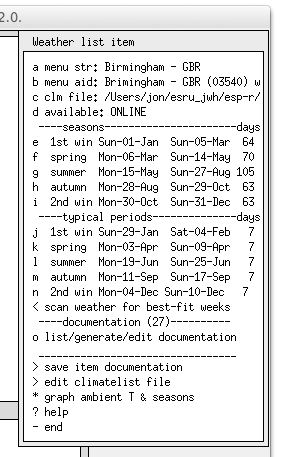
In support of lighting controls and heat transfer at facades the following are derived at simulation time:
ESP-r includes a facility for holding short term data to be used within a simulation. The kinds of entities:
Flow components (icons)
ESP-r offers both mass flow definitions based on tag:data text descriptions or a graphic/icon definition of networks. For each of the standard mass flow types there are graphic prototypes held in an icons database. These include as attributes:
Environmental system components
ESP-r detailed plant systems are defined via a network of components. The plant component database holds base entities (e.g. steam humidifier, coils, heat exchangers) from which the model system network is built. A listing of the components included in a mechanical ventilation scheme is shown below:
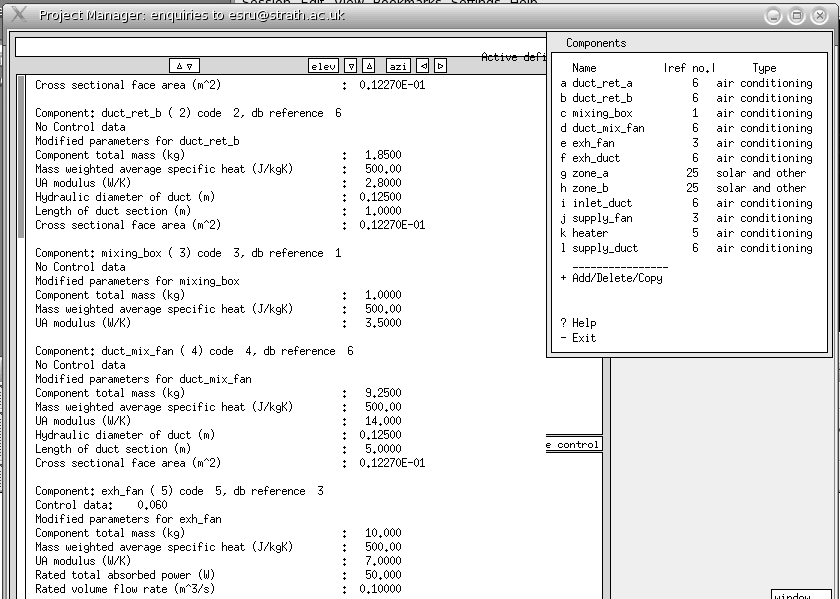
Instances in the network are updated with project-specific attributes as they are selected. All plant components are finite volume representations. Indeed, there may be several components which represent the same device with different levels of internal resolution (e.g. a 2 node domestic radiator or an 8 node domestic radiator). Each entity includes definitions for the finite volumes and matrix layout as well as equivalent mass flow component attributes.
Electrical, Wind and Phase-change
ESP-r includes a database which holds additional attributes for a number of advanced topics:
Each entity is typed and entities of specific types are exposed in the interface were appropriate.
Predefined entities
In support of multi-domain assessments (visual and thermal) ESP-r has a database of pre-defined entities such as desks, chairs, stairs and facade elements. Each has sufficient attribution to be integrated into the model with minimal user interactions.
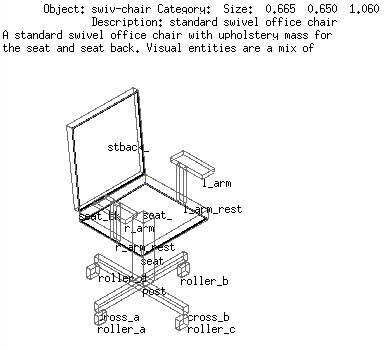
Pre-defined entities are currently included in the following categories - office furniture, house furniture, stairs, system components, facade components, lighting fixtures. Each has the following types of attributes:
The thermal mass surfaces become surfaces within zones and participate fully in the zone energy balance, insolation and viewfactor patterns. If you are planning on populating offices, such as open plan spaces with many chairs, desks and filing cabinets you may want to use a version of ESP-r that has been compiled to support complex models (typically up to 200 surfaces per zone although we have tested 240 surface zones).
Used carefully, pre-defined entities allow users to approach the complexity observed within real spaces. Multi-criteria assessments which include local thermal and glare comfort begin to be possible. In the image below just about everything in the image is thermophysically real i.e. complsed of explicit thermal and visual entities.
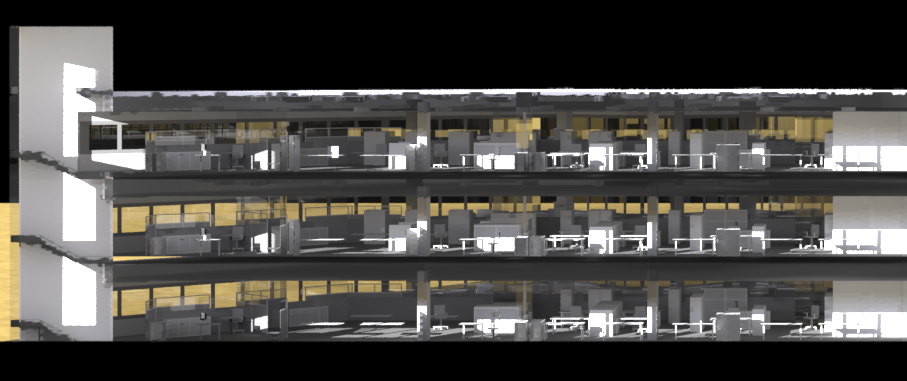 see full zize
see full zize
The thermal bounding surfaces are used with the entity becomes a zonal representation in ESP-r - for example an explicit thermostat or a stair. Currently when zonal entities are used they result in a single zone. Later system components which are better represented as multiple zones will be supported.
Back to top | Back to Welcome page